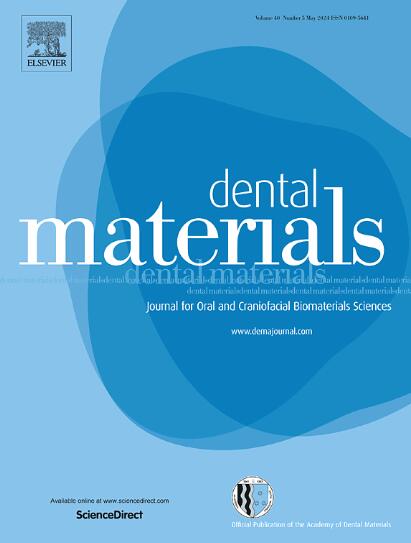用于牙髓治疗的溶胶凝胶硅酸钙水泥,含有胶原蛋白和介孔生物玻璃纳米颗粒。
IF 4.6
1区 医学
Q1 DENTISTRY, ORAL SURGERY & MEDICINE
引用次数: 0
摘要
目的:硅酸钙水门汀(CSCs)尽管在物理性质和抗菌效果方面存在一些局限性,但仍经常用于牙髓治疗。本研究旨在开发并证明一系列通过溶胶-凝胶法生产并用介孔生物活性玻璃纳米颗粒(MBGNs)和胶原蛋白进一步修饰的 CSCs 在牙髓治疗中的可行性:方法:采用溶胶-凝胶法合成了硅酸钙(CS)颗粒和 MBGNs,并对其元素、分子和物理微观结构进行了表征。通过将 CS 与蒸馏水(CS+H2O)、10 mg/mL 胶原蛋白溶液(CS+colH2O)和 MBGNs(10 %)(CSmbgn+colH2O)混合,制备了三种 CSC。测定了 CSCs 的混合时间(MT)和凝固时间(ST),并对凝固反应进行了实时监测。此外,还分析了对粪肠球菌(E. faecalis)的抗菌效果以及牙髓干细胞(DPSCs)的再生潜力:结果:CS+H2O 的 ST 值与商业产品相当,而 CSmbgn+colH2O 的 MT 值最长为 68 秒,ST 值最短为 8 分钟。所有实验性 CSCs 都抑制了粪大肠杆菌的生长。此外,与对照组相比,无论其成分如何,造血干细胞都支持细胞增殖、扩散和矿化基质的生成:意义:经过测试的造血干细胞具有作为牙髓治疗程序候选细胞的潜力。未来的研究应在研究牙髓再生机制的同时进行严格的抗菌评估,最好是对多生物体生物膜进行长期评估。本文章由计算机程序翻译,如有差异,请以英文原文为准。
Sol-gel-derived calcium silicate cement incorporating collagen and mesoporous bioglass nanoparticles for dental pulp therapy
Objective
Calcium silicate cements (CSCs) are often used in endodontics despite some limitations related to their physical properties and antibacterial efficacy. This study aimed to develop and demonstrate the viability of a series of CSCs that were produced by sol-gel method and further modified with mesoporous bioactive glass nanoparticles (MBGNs) and collagen, for endodontic therapy.
Methods
Calcium silicate (CS) particles and MBGNs were synthesized by the sol-gel method, and their elemental, molecular, and physical microstructure was characterized. Three CSCs were developed by mixing the CS with distilled water (CS+H2O), 10 mg/mL collagen solution (CS+colH2O), and MBGNs (10 %) (CSmbgn+colH2O). The mixing (MT) and setting (ST) times of the CSCs were determined, while the setting reaction was monitored in real-time. Antibacterial efficacy against Enterococcus faecalis (E. faecalis) and regenerative potential on dental pulp stem cells (DPSCs) were also analyzed.
Results
The CS+H2O displayed a ST comparable to commercial products, while CSmbgn+colH2O achieved the longest MT of 68 s and the shortest ST of 8 min. All the experimental CSCs inhibited the growth of E. faecalis. Additionally, compared to the control group, CSCs supported cell proliferation and spreading and mineralized matrix production, regardless of their composition.
Significance
Tested CSCs presented potential as candidates for pulp therapy procedures. Future research should investigate the pulp regeneration mechanisms alongside rigorous antibacterial evaluations, preferably with multi-organism biofilms, executed over extended periods.
求助全文
通过发布文献求助,成功后即可免费获取论文全文。
去求助
来源期刊

Dental Materials
工程技术-材料科学:生物材料
CiteScore
9.80
自引率
10.00%
发文量
290
审稿时长
67 days
期刊介绍:
Dental Materials publishes original research, review articles, and short communications.
Academy of Dental Materials members click here to register for free access to Dental Materials online.
The principal aim of Dental Materials is to promote rapid communication of scientific information between academia, industry, and the dental practitioner. Original Manuscripts on clinical and laboratory research of basic and applied character which focus on the properties or performance of dental materials or the reaction of host tissues to materials are given priority publication. Other acceptable topics include application technology in clinical dentistry and dental laboratory technology.
Comprehensive reviews and editorial commentaries on pertinent subjects will be considered.
 求助内容:
求助内容: 应助结果提醒方式:
应助结果提醒方式:


